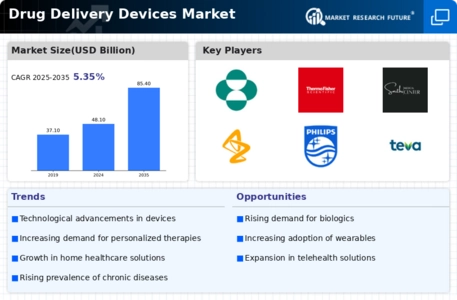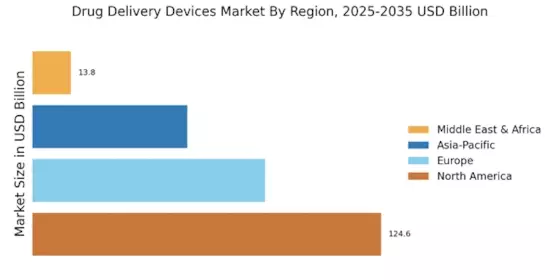Rising Prevalence of Chronic Diseases
The increasing incidence of chronic diseases such as diabetes, cardiovascular disorders, and respiratory ailments is a primary driver of the Drug Delivery Devices Market. As these conditions require long-term management, the demand for effective drug delivery systems is surging. For instance, the World Health Organization reports that chronic diseases account for approximately 60% of all deaths worldwide. This trend necessitates innovative drug delivery solutions that enhance patient compliance and therapeutic outcomes. Consequently, the market for drug delivery devices is projected to expand significantly, with estimates suggesting a compound annual growth rate of over 7% in the coming years. This growth is likely to be fueled by advancements in technology and the increasing focus on patient-centric healthcare solutions.
Technological Advancements in Drug Delivery
Technological innovations are transforming the Drug Delivery Devices Market, leading to the development of more efficient and targeted delivery systems. Recent advancements in nanotechnology, microfluidics, and smart drug delivery systems are enhancing the precision and efficacy of treatments. For example, the integration of wearable devices and implantable systems allows for continuous monitoring and administration of medications, thereby improving patient outcomes. The market is witnessing a shift towards these advanced technologies, with projections indicating that the segment of smart drug delivery devices could grow at a rate exceeding 10% annually. This trend reflects a broader movement towards personalized medicine, where treatments are tailored to individual patient needs, further driving the demand for innovative drug delivery solutions.
Growing Demand for Self-Administration Devices
The rising preference for self-administration of medications is significantly influencing the Drug Delivery Devices Market. Patients increasingly seek convenience and autonomy in managing their health, leading to a surge in demand for devices that facilitate self-administration. This trend is particularly evident in the management of chronic conditions, where patients prefer devices that allow them to administer their medications at home. The market for self-injection devices, for instance, is expected to witness substantial growth, with estimates suggesting a market size of over 10 billion dollars by 2026. This shift towards self-administration not only enhances patient compliance but also reduces the burden on healthcare systems, thereby driving the overall growth of the drug delivery devices market.
Increasing Investment in Healthcare Infrastructure
The ongoing investment in healthcare infrastructure is a pivotal driver of the Drug Delivery Devices Market. Governments and private entities are allocating substantial resources to enhance healthcare facilities and improve access to medical technologies. This investment is particularly evident in emerging economies, where the demand for advanced healthcare solutions is rising. Enhanced healthcare infrastructure facilitates the adoption of innovative drug delivery devices, as hospitals and clinics are better equipped to implement these technologies. Market analysts predict that this trend will lead to a significant increase in the utilization of drug delivery devices, with an expected market growth rate of around 8% over the next few years. This investment not only improves patient care but also stimulates economic growth within the healthcare sector.
Regulatory Support for Innovative Drug Delivery Solutions
Regulatory bodies are increasingly supporting the development and approval of innovative drug delivery solutions, which is a crucial driver for the Drug Delivery Devices Market. Initiatives aimed at expediting the approval process for novel drug delivery systems are encouraging manufacturers to invest in research and development. For instance, the U.S. Food and Drug Administration has introduced programs that facilitate faster review times for breakthrough devices. This regulatory support is likely to foster innovation and bring new products to market more swiftly, thereby enhancing competition and expanding the range of available drug delivery options. As a result, the market is expected to experience robust growth, with a projected increase in the number of approved devices in the coming years.


















Leave a Comment